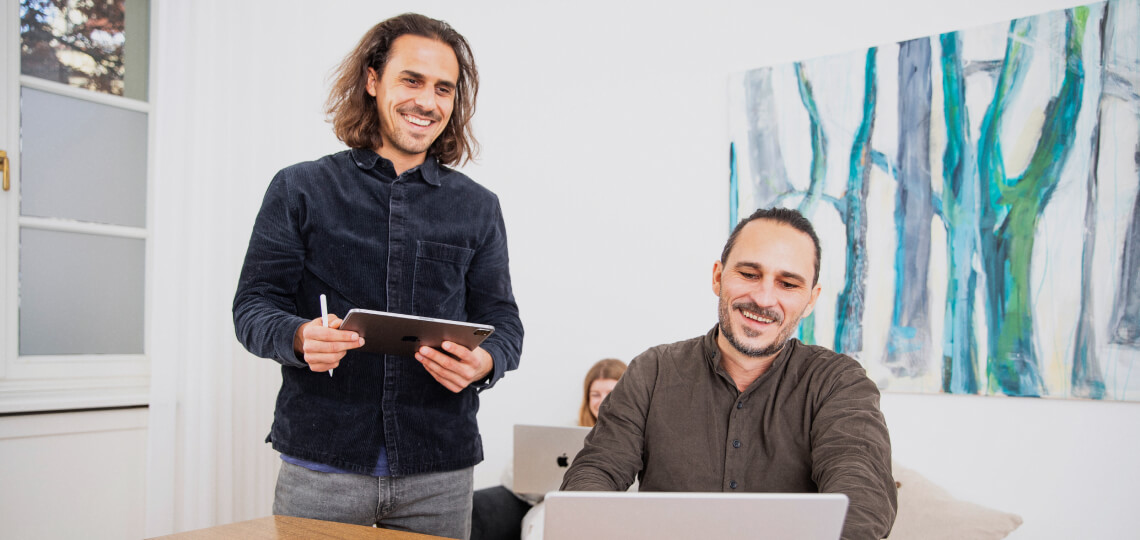In a nutshell: What is B-roll?
B-Roll is the visual spice that brings your videos to life. It adds depth and emotion, keeps viewers captivated and transforms simple shots into professional narratives.
What is B-roll & how to use it correctly in video marketing?
Imagine your video is a painting - the B-roll is the color that adds depth and nuance. This article dives deep into the world of B-roll and highlights its invaluable value for video productions of all kinds. From its historical origins to modern techniques, I cover it all.
Not only will you learn how good B-roll tells visual stories, but also practical tips on shooting different angles and using stock footage as a time-saving resource. In addition, it will become clear why professional videos are simply not complete without these secondary shots.
Armed with this knowledge, you can create content that engages your viewers while increasing the production value of your videos. Whether you're a beginner or an experienced video producer, B-roll is a key to improving your videos and increasing visual quality.
Understanding B-roll in video production
B-roll is the visual salt in the soup of your video production. It's about complementing your main shots - called A-roll - and giving them depth and context. But what exactly do you mean by B-roll? Historically, the term comes from the days of film editing on celluloid, when the material for overlays and cuts was often stored on a second roll - hence "B" for "background". Today, you use this term for all kinds of additional material, be it to tell stories better or simply to make cuts invisible.
-
Free
SEO strategy meeting
In a free SEO strategy talk, we uncover untapped potential and develop a strategy to help you become more successful on Google.

- More organic visibility
- More organic visitors to your website
- More inquiries & sales
The definition and origin of B-roll
The definition of B-roll has evolved over the years. Originally, it was alternative shots to the main action of a video. Now, this part of the production plays a crucial role in creating a smooth film flow. A well-placed establishing shot can make scene changes natural and help the audience perceive the surroundings.
But establishing shots are not the only type of B-roll: cutaway shots show details or secondary aspects of a scene; atmospheric shots capture moods without being directly narrative; close-up shots concentrate on small but significant elements in the frame.
The art of visual storytelling with B-roll
There are few things more important in a feature film than the art of visual storytelling with the help of high-quality B-roll footage. These images keep the audience engaged and give room to breathe between dialog-heavy passages - they are as essential as the dialog itself. Think of reality TV productions: Without these additional shots, a lot of it would seem monotonous.
But even beyond big screens, this concept has become indispensable - whether it's promotional videos or wedding films, good B-roll footage makes the difference between amateur content and professional results. A skillful shooting of B-roll thus offers added value through additional visual elements that support and deepen the main narrative. They enrich the storytelling with context and emotion so that the viewer enjoys a more rounded experience.
The role of B-roll in professional videos
B-roll is the invisible spice that makes professional video productions really tasty. Imagine an interview without the right atmospheric shots - it would be like soup without salt. But what exactly is this B-roll and why should you use it?
Improve storytelling with additional film material
By using B-roll, video creators add depth to their main shots and keep the audience engaged. These additional shots add context to the video and can provide alternative angles or simply create pauses between scenes to allow for a smooth transition.
In addition to visual variety, B-roll also hides cuts, making interviews appear more natural. For example, if background noise interferes during a conversation, a cleverly placed B-roll can cover up this flaw and provide interesting insights at the same time.
- Do you know my SEO newsletter?
Register now and receive regular tips from the experts.
Increase production quality with high-quality B-roll
High-quality rolling stock takes your production to a new level - amateur videos become polished masterpieces with cinematic quality. The right choice of establishing shots not only provides important information about the time and place of the action, but also makes your video appear more vivid.
But as a good movie producer, you know: It's not just about collecting any footage; you carefully plan your B-roll shot list in advance for each scene of your feature or documentary.
One effective method is to use stock footage as a resource for high quality footage when time or budget doesn't allow for your own shoots. This keeps your content fresh and engaging without the added expense of shooting in exotic locations or complicated setups.
Mastering the B-roll recording techniques
Dynamic secondary footage is the secret of every professional video production. It complements your main content and visually enriches your content. Here's a guide to shooting dynamic secondary footage that complements your main video content.
Camera angles and techniques
Tips for shooting different angles that add depth to your story. Think of the establishing shot that introduces a scene, or the wide angle shot for landscape shots. Close-up shots of objects can also create atmosphere and make your audience feel like they're right in the middle of the action - providing context without a lot of words.
Also use different camera angles: Time-lapse can show changes over time, while a slow-motion sequence captures more emotion.
Making the right choice
High-quality B-roll shots don't just fall out of the sky; you need to know what you want to capture. Create a B-Roll Shot List Example to ensure that no important image is forgotten. The list helps you to capture relevant scenes and ensures that your material remains diverse.
Integrating B-roll into video editing
Incorporating B-roll into video editing is like seasoning a dish: it can turn a good video into an excellent one. Incorporating B-roll with the main footage creates visual interest and keeps the viewer captivated.
If we look at a typical interview clip, it could appear monotonous without any additional material. But if you add suitable cutaway shots, you create an atmosphere that gives the viewer more context and keeps them in the action. Breathtaking wide-angle shots or sharp close-up shots offer a wealth of possibilities here.
A well thought out shot list is crucial for shooting relevant B-roll; it should include a variety of camera angles to add depth to your story. Check out sample shot lists for inspiration.
Choosing the right material
Fishing out the gold from a sea of footage requires practice and skill. The trick is to find atmospheric shots that capture the mood without distracting from the primary video material - because good B-roll complements rather than dominates.
You should always be on the lookout for alternative footage - you never know when it can help save a scene by hiding unsightly cuts or simply providing some "breathing room" between intense moments of action.
These additional shots are not only popular for feature films, but are also an indispensable part of any reality TV production or documentary.
Understanding editing strategies
When it comes to editing, not every roll video fits everywhere; you need to know where which secondary footage is at its best. Editing is all about using additional content to fill natural pauses and make scene transitions smoother - all while keeping the main content clearly recognizable.
Don't forget to use quality stock footage. This can enrich the production and give the final product a professional polish.
Stock footage as a resource for B-roll
B-roll is the salt in the soup of your video production. It adds depth and context to the main video, keeps the audience engaged and cleverly disguises cuts. But what to do when there's not enough time or budget to shoot your own footage? This is where stock footage libraries come into play.
Using archive material as supplementary footage can be a real game changer. You save the cost of days of filming and still get high-quality footage. The great thing is that these treasures are often even available for free or at very reasonable prices - perfect for video creators on a tight budget.
Advantages of stock material at a glance
Quality B-roll footage from stock footage collections can greatly increase the production value of a video - they quickly give an amateur video a professional edge. You don't have to spend a fortune; many websites offer free or affordable B-roll footage online that is easily accessible.
But that's not all: with this alternative film material, you also have a greater variety of camera settings at your disposal without having to film every angle yourself. Whether wide landscape panoramas or close-ups of small objects - everything is ready for use in your own project.
B-roll from stock footage saves your budget. Save costs, gain quality and variety for videos. #Video production #FilmmakingTips
Click to tweet.
Distinction between A-roll and B-roll
In the world of video production, A-roll and B-roll are the yin and yang components that flow together to enrich our viewing experience. But what separates the two? The main shots, also known as A-roll, form the backbone of any video. They usually contain dialog or interviews - the core content.
The primary role of A-Rolls
At a wedding, for example, this would be the "I do" or the questions to the speaker in an interview. This material is essential; it provides context and keeps our interest firmly focused on the goal. But even an exciting conversation can be marred by visual monotony - this is where the importance of B-roll comes into play.
Significant additions through B-roll
B-roll offers variety in the field of vision: close-ups of the ring exchange during a wedding ceremony or alternative shots from other angles can provide deeper insights and enhance emotional resonance. Often this additional footage is used to hide cuts and at the same time gives the viewer 'breathing room'. You could say that good B-roll footage makes you feel a story rather than just telling it.
It also helps to incorporate relevant atmospheric images such as wide-angle shots of the venue or scenic cuts - keyword establishing shots - which in turn can increase audience engagement.
Even if you can't film on location, footage libraries offer a wealth of stock footage to support the narrative strand without having to pile up huge costs for your own shoots. Find free resources for high-quality stock footage online. By skillfully editing these secondary shots with the main video, you'll ultimately get a feature film production feel - captivating to the last second.
Conclusion on the subject of YMYL
B-Roll is the secret of vivid videos. It gives your stories color and context. You've learned how important these secondary shots are - they enrich the narrative and keep viewers engaged.
Remember: good B-roll creates atmosphere. It fills gaps, hides cuts and brings variety to your angles.
Be strategic: Plan your B-roll wisely; use stock footage as a source of high-quality clips without having to shoot it yourself.
And always remember the value of detail. Small scenes often make a big difference - whether in documentaries or reality TV.
One final tip: stay engaged when editing your videos; that way your audience will stay engaged until the end.






